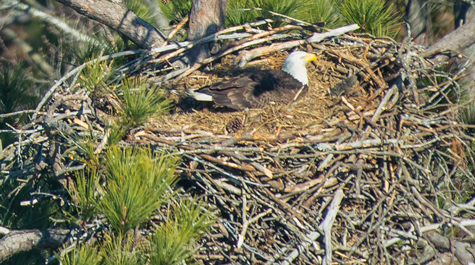James River population of bald eagles continues to grow, but more slowly
The breeding bald eagle population of the James River is still growing, but it’s slowing.
That’s the initial report from the three-man aerial survey squad of William & Mary’s Center for Conservation Biology, which completed the first leg of its annual eagle census of the James River just as social-distancing guidelines were announced.
The survey team consists of Bryan Watts, director of the center, and Mitchell Byrd, co-founder of the center and Chancellor Professor of Biology, Emeritus. As they have for years, Watts and Byrd spot and tally the eagles from the cabin of a Cessna flown by a former fighter pilot who introduces himself as Captain Fuzzzo — “The middle ‘z’ is silent,” he explains.
Aerial eagle censuses of the James have been conducted since 1962. Next year will mark the 30th year for Watts to do the James River survey and Byrd’s 45th year.
“The James survey is pretty interesting, because of all the four major tributaries of the Chesapeake Bay, the James is the only one where the eagle population got down to zero,” Watts said.
The recovery of bald eagles in the eastern U.S. began in the 1970s, with the banning of DDT and passage of federal legislation protecting the national bird. And the eagles came back: Watts said he expects the tally of James River eagles to be up slightly for 2020.
“Last year we broke 300 pairs, which was a milestone,” he said. He pointed out that 300 pairs was the recovery goal set for the entire Chesapeake Bay. “So for the James alone to reach that? It was completely unexpected by everybody,” Watts said.
He said he wouldn’t have hard numbers until the team does its productivity survey in April, but Watts estimates that the tally will be around 310 pairs.
“The population growth is definitely slowing,” he said. “If you look two years ago, we were at 289. Last year we were 302.”
Watts said that the eagle population grew from eight to ten percent per year since recolonization of the James. The growth rate held from the 1980s through the 2010s but has begun to level off.
Eagle pairs are laying as many eggs in a clutch, he said, but are able to bring fewer offspring to fledgling status. Watts explained that more and more birds are reaching reproductive age only to discover there is no available breeding territory.
“They only have a couple of options,” Watts said. “One is to disperse. They leave the area — and Bay is responsible for the growth in the eagle population of all the neighboring states.”
The other option is to stick around and compete for mates and breeding territory. Watts says biologists refer to such unattached birds as “floaters.”
“That sort of situation sets up a conflict between the haves and the have-nots,” he said. “And the have-nots are just relentlessly disrupting the active breeders.”
Bald eagle domestic life, Watts explains, revolves around the nest. Eagles prefer to nest close to a large body of fish-producing water, high in a large hardwood or pine that dominates the forest canopy.
“The females are the ones that do the chick rearing,” Watts said. “So when you fly over these nests, what you see is a female on the nest with young chicks. And the male will be in a guarding position usually within 20 yards or so of the nest — a tall snag or tree where they have good visibility so they can detect intruders.”
The intruders are the floaters, trying to evict a couple to take over their breeding territory. Watts said the nesting males have to divide their time between guarding his mate and offspring and feeding them. The result is fewer chicks in each nest reaching maturity.
“They are producing the same number of eggs,” Watts said. “They're hatching the same number of chicks. And we have what's referred to as brood reduction, where the brood will be reduced down to the level of food that's coming in.”
Intra-eagle conflict is mainly due to nest intrusion by floaters. Watt said that successfully breeding eagle pairs rarely have conflicts with their neighbors, even when they nest within 50 yards of each other.
Life has changed for the eagles of the James River more than it has for the Center for Conservation Biology scientists that study them. The methodology of the census itself is the same as it has been for decades: Watts sits in the back seat of the plane, spotting. He calls out the nests to Byrd, who rides copilot, noting each nest on a topographic map. Meanwhile, Captain Fuzzzo keeps the Cessna bobbing and rocking like a dragonfly at altitude low enough for Watts to count the chicks in the nest. The nests go by at a rapid clip.
“I can't tell you how intense it is in the plane,” Watts said. “Hitting nest after nest every few seconds. You know, it's hard to keep up with that.”
He said that he wants to keep the eagle survey going indefinitely.
“This is a long-lived species,” he said. “And next year, we’ll have a 60-year dataset that covers generations of these birds. It shows the most complete recovery of these birds that I know of.”















